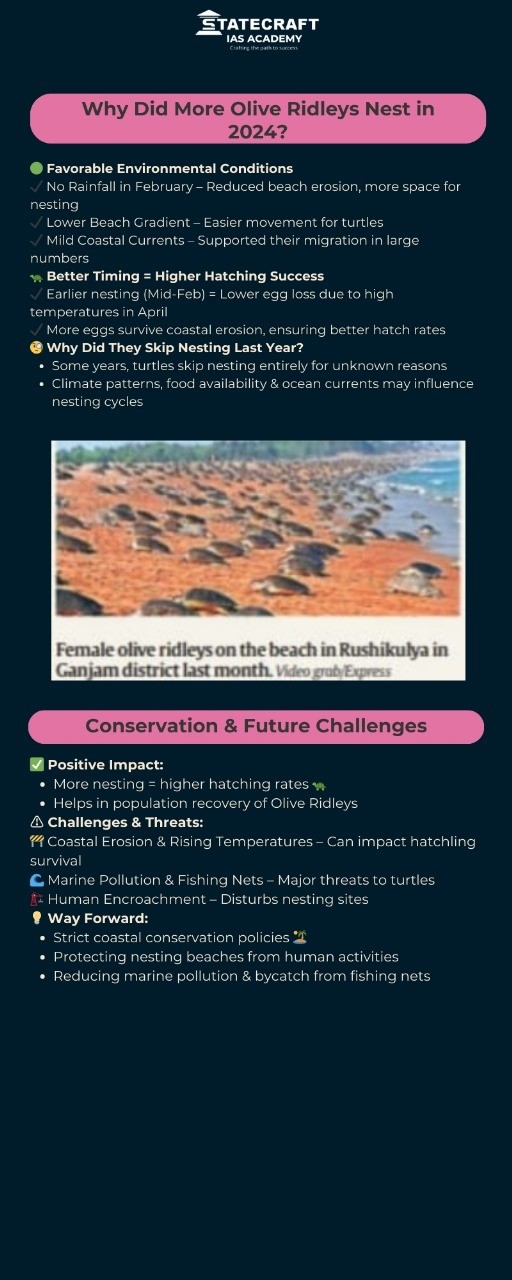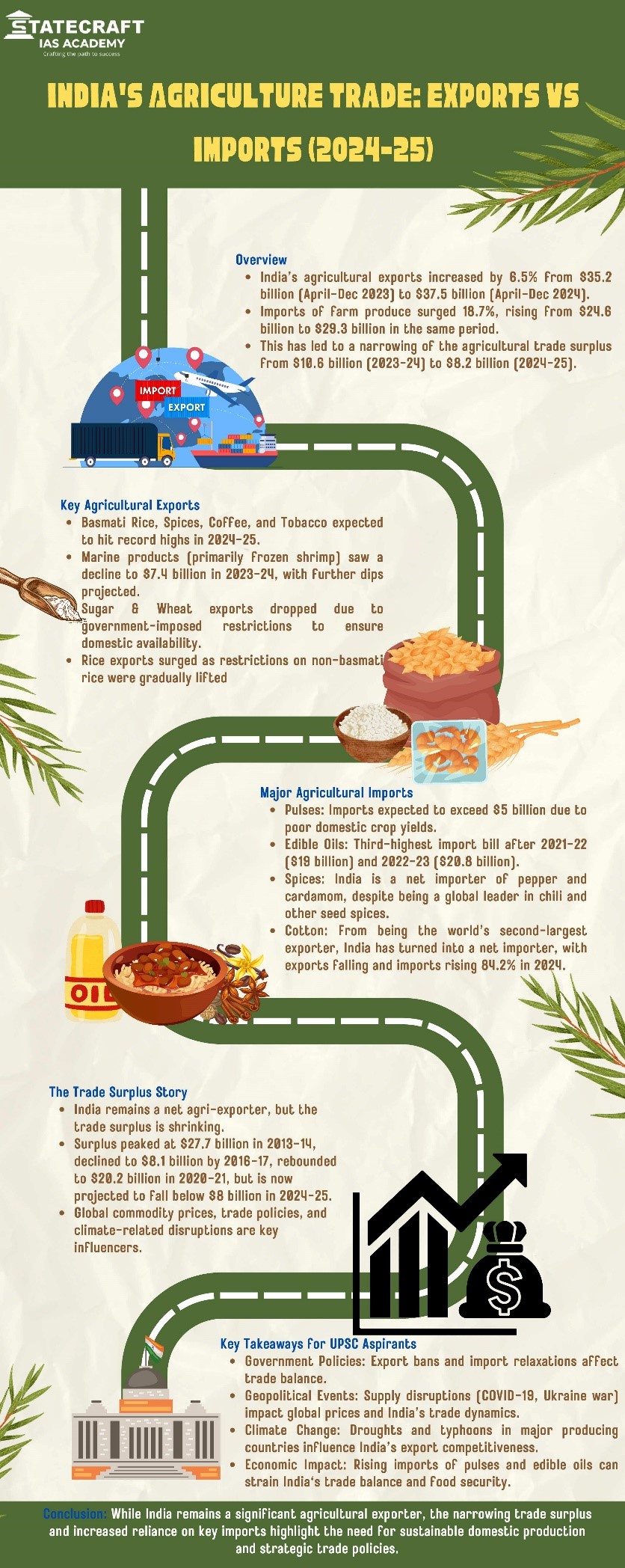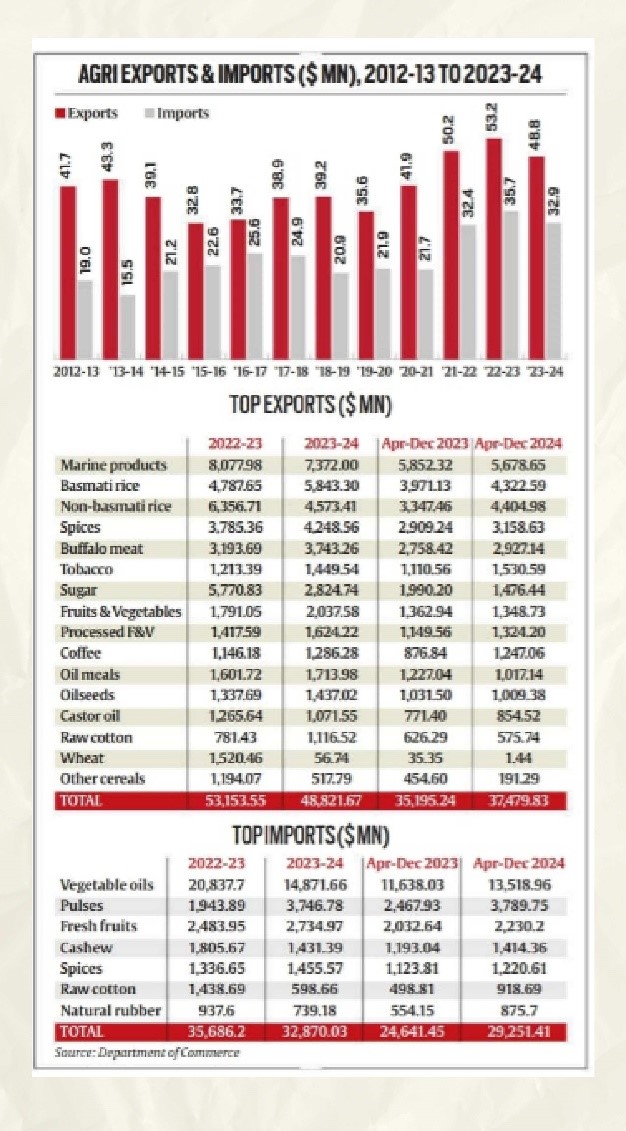Index:
- Gangetic Dolphin Survey 2024
- Cities Coalition for Circularity (C-3)
- Supreme Court on Regulation of Vulgarity Online
- India's Economic Growth in Q3FY25
- Ukraine Ceasefire Plans & Global Reactions
- Rise in Women Seeking Retail Credit
- Trump's Focus on Virtual Digital Assets & Crypto Reserve
- Other News Headlines
- Why Did More Olive Ridleys Nest in 2024? -Infographics
- Why Olive Ridleys Came to Odisha in Larger Numbers This Year -Infographics
- MOON LANDINGS 2024: THE ERA OF PRIVATE SPACE MISSION -Infographics
- MAKING SENSE OF INDIA’S GDP DATA -Infographics
1. Gangetic Dolphin Survey 2024
Key Findings
- Total Population: 6,327 Gangetic dolphins recorded in India.
- Gangetic River Dolphins: 6,324
- Indus River Dolphins: 3
Geographical Distribution
- Ganga Main Stem: 3,275
- Ganga Tributaries: 2,414
- Brahmaputra Main Stem: 584
- Brahmaputra Tributaries: 412
- Beas River: 101
States with Highest Population
- Uttar Pradesh (highest)
- Followed by Bihar, West Bengal, and Assam
Survey Details
- Conducted by the Environment Ministry
- Started in 2021, covering 8,507 km of river stretch
- Used acoustic hydrophones to detect dolphin sounds
Challenges in Counting Dolphins
- Dolphins surface only sporadically, making visual detection difficult
- No unique physical markers like stripes (tigers) or ears (elephants)
- Possibility of double counting, tackled using hydrophones and multiple observers
Conservation Measures
- Gangetic dolphins are crucial for river health monitoring
- Threats: Pollution, habitat destruction, fishing nets
- Initiatives: Local populations in the Gangetic States identified for conservation efforts
Awareness: School children encouraged to visit dolphin habitats
2. Cities Coalition for Circularity (C-3)
Context
- India launched Cities Coalition for Circularity (C-3), a multi-nation alliance for sustainable urban development.
- Focus on city-to-city collaboration, knowledge sharing, and private sector partnerships.
- Aim: Waste management and resource efficiency in the Asia-Pacific region.
Key Themes
- Reduce, Reuse, Recycle (3R):
- Emphasized by PM Narendra Modi under the Pro-Planet People (P3) approach.
- Highlights circular economy principles for sustainable urban development.
- International Collaboration:
- India proposes a working group of member nations to finalize the framework of the coalition.
- CITIIS 2.0 MoU signed at Jaipur launch event.
- Financial Commitments:
- Union Minister Manohar Lal announced agreements worth ₹1,800 crore.
- 18 cities across 14 states to benefit under this initiative.
Environmental Impact
- Regional 3R and Circular Economy Forum (Asia-Pacific) launched in 2009 for:
- Sustainable waste management
- Resource efficiency
- Circular economy principles
- Hanoi 3R Declaration (2013-2023):
Outlined 33 voluntary goals for a resource-efficient and circular economy.
3. Supreme Court on Regulation of Vulgarity Online
Context
- The Supreme Court (SC) has sought regulatory measures to control the use of filthy language and vulgarity in online content.
- The focus is to maintain morality and decency in streamed programs without censorship.
Observations by the Court
- Justice Surya Kant:
- Humour should be family-friendly and not rely on filthy language.
- True talent lies in using ordinary words for humour.
- Regulation vs. Free Speech:
- SC emphasized ensuring content adheres to moral standards while respecting freedom of speech.
- Any restriction should be a reasonable limitation to uphold decency and morality.
- The court seeks stakeholder inputs for a healthy debate on the matter.
Case Context: Ranveer Allahbadia’s Podcast Ban
- Issue: His comments on the show “India Got Latent” led to restrictions on his content.
- SC Decision:
- Modified the restriction, permitting the resumption of “The Ranveer Show”, provided it follows morality and decency
- Ensures content remains suitable for all age groups.
Arguments Presented
- Petitioner’s Argument (Ranveer Allahbadia’s Lawyer):
- Ban on podcasts and shows would affect his livelihood.
- No sense of humour was involved in the alleged offensive comments.
- Solicitor-General Tushar Mehta:
Humour should not rely on obscenity; true comedy should be genuinely funny without offensive language.
4. India's Economic Growth in Q3FY25
Context
- Real GDP Growth: 2% in Q3FY25 (compared to 5.6% in Q2FY25).
- Slowest growth since Q4FY23 (except for Q2FY25).
- Government’s 6.5% full-year growth target seems unlikely due to global headwinds and domestic slowdown.
Sector-wise Growth Trends
- Primary Sector:
- Value-add increased to 5.2% (from 1.8% last year).
- Helped sustain overall GDP growth.
- Manufacturing & Services (Secondary & Tertiary Sectors):
- Manufacturing growth fell to 4.8% (from 12.4% last year).
- Services growth slowed to 7.4% (from 8.3% last year).
- Weakness due to global trade uncertainties.
Challenges & Risks
- Trade Uncertainty:
- S. tariffs: 25% import tariff on steel and proposed 25% tariff on pharmaceuticals.
- India’s dependency on the U.S.: 31% of India’s pharma exports ($8.7 billion) go to the U.S.
- Firms may pivot production to the U.S., impacting India’s trade revenue.
- Inflation & Domestic Demand:
- Inflation projected at 4.8% in FY25, expected to ease to 4.2% in FY26.
- Moderation in inflation helped increase government spending (+8.3%) and private consumption (+6.9%).
Data & Methodology Concerns
- NSO’s Revision in GDP Estimates:
- Methodological changes based on “industry-wise/institution-wise” information.
- Lacks clarity on its impact on data quality and accuracy.
Need for more transparent revisions to ensure data reliability.
5. Ukraine Ceasefire Plans & Global Reactions
Context
- European nations, led by Britain and France, are discussing possible ceasefire proposals for the Ukraine war.
- France proposed a one-month ceasefire as an initial step toward peace talks.
- Discussions follow a meeting between Donald Trump and Ukrainian President Volodymyr Zelenskyy in the U.S.
Key Stakeholders & Their Positions
- United Kingdom (UK):
- Acknowledges multiple proposals but avoids detailed commentary.
- France & Britain:
- Considering sending troops to Ukraine, but not for direct war involvement.
- France suggests a temporary ceasefire to test Russia’s intentions for peace.
- United States (US) & Trump’s View:
- Trump claims Zelenskyy “doesn’t want peace” and questions continued American support.
- White House security officials say European involvement is welcome but needs investment in defense capabilities.
- Ukraine’s Position:
- Zelenskyy rejects a ceasefire without explicit security guarantees ensuring Russia will not attack again.
- Asserts that European military support alone is not enough without US backing.
- Russia’s Reaction:
- Kremlin spokesman Dmitry Peskov dismisses the US and Europe’s efforts as insufficient for ending the war.
- Suggests that Russia may push for a tougher deal than it did in 2022 peace talks, which Ukraine rejected.
Geopolitical Implications
- European Troop Deployment:
- France and Britain’s willingness to send troops (not for combat) may escalate tensions.
- US-EU Relations:
- Europe is seeking greater US involvement, but Trump and sections of the US question continued military aid.
- Russia’s Negotiation Tactics:
- Russia may demand more concessions, such as Ukraine adopting neutrality, reducing military size, and avoiding NATO.
- Potential for Peace Talks:
- The one-month ceasefire proposal could test Russia’s commitment to peace.
Lack of US endorsement may weaken the proposal’s effectiveness.
6. Rise in Women Seeking Retail Credit
Context
- The number of women availing retail credit in India has nearly tripled between 2019 and 2024.
- This reflects a changing financial behavior with more women leveraging credit for personal and professional goals.
- Growth rate: 22% CAGR (Compound Annual Growth Rate) over five years.
Key Trends
- Increase in Credit Demand
- Women’s share in business loans and gold loans increased by 14% and 6%, respectively, since 2019.
- In 2024, 36% of all loans availed by women were gold loans (up from 19% in 2019).
- Women from semi-urban and rural areas account for 60% of borrowers.
- Types of Loans Preferred by Women
- Gold loans dominate: 38% of all loans taken by women are against gold.
- Personal finance loans (personal, consumer durable, homeownership loans) are the major share of women’s borrowing.
- Business credit for women remains low, with most loans being collateral-backed.
- Challenges for Women Borrowers
- Credit aversion and poor banking experience.
- Lack of collateral and guarantees for business loans.
- Barriers to credit readiness (financial literacy, documentation issues).
- Growth in Self-Monitoring of Credit Health
- Women checking their credit scores increased by 42% (from 18.9 million in Dec 2023 to 26.92 million in Dec 2024).
- Self-monitoring helps in informed financial decision-making and entrepreneurship.
- Demographic Insights
- Gen Z (born mid-1990s to early 2010s) accounts for 19.43% of the total self-monitoring base (up from 17.89% in 2023).
- Indicates growing financial awareness among young women.
Implications for Economy & Society
- Financial Inclusion: More women entering the formal credit system.
- Women Entrepreneurship: Business loans remain underutilized, requiring better support systems.
- Economic Growth: More women leveraging credit can boost consumption and investments.
Policy Considerations: Need for targeted schemes to improve women’s access to unsecured credit.
7. Trump's Focus on Virtual Digital Assets & Crypto Reserve
Context
- Former US President Donald Trump has announced plans to create a “Crypto Strategic Reserve” if re-elected.
- He named five cryptocurrencies to be included in this reserve:
- Bitcoin (BTC)
- Ethereum (ETH)
- XRP
- Solana (SOL)
- Cardano (ADA)
- This move has given a boost to the crypto market, leading to a sharp rise in prices.
Key Announcements & Market Impact
- Rationale Behind the Crypto Reserve
- Trump cited concerns over attacks on the crypto industry by the Biden administration.
- Advocated for US dominance in the digital asset space, calling the US “the Crypto Capital of the World.”
- Market Reactions
- Bitcoin surged over 8%, crossing $90,000.
- Ethereum rose 10%, trading at over $2,000.
- XRP increased nearly 25%, Solana jumped 18%, while Cardano surged 60%.
- Prices rose due to speculation that Trump might ease regulations on cryptocurrencies.
- Concerns & Risks
- Volatility: Cryptocurrencies remain highly volatile.
- Fraud & Scams: Example of Argentina’s failed “Libra” coin, promoted by President Javier Milei.
- Regulatory Issues: The US SEC (Securities and Exchange Commission) has been investigating crypto firms.
- Potential Policy Influence
- Trump may appoint crypto-friendly regulators like Paul Atkins to the SEC.
- Speculation that Elon Musk (a crypto advocate) may join as an adviser.
- Geopolitical & Economic Implications
- Trump’s trade policies, including tariff wars, add uncertainty to markets.
- US government’s stance on crypto regulations could impact global markets.
Institutional interest in crypto may increase due to official recognition.












